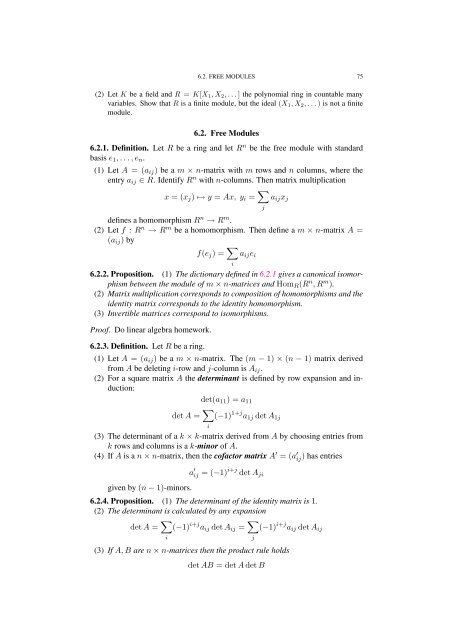Commutative algebra - Department of Mathematical Sciences - old ...
Commutative algebra - Department of Mathematical Sciences - old ...
Commutative algebra - Department of Mathematical Sciences - old ...
You also want an ePaper? Increase the reach of your titles
YUMPU automatically turns print PDFs into web optimized ePapers that Google loves.
6.2. FREE MODULES 75<br />
(2) Let K be a field and R = K[X1, X2, . . . ] the polynomial ring in countable many<br />
variables. Show that R is a finite module, but the ideal (X1, X2, . . . ) is not a finite<br />
module.<br />
6.2. Free Modules<br />
6.2.1. Definition. Let R be a ring and let R n be the free module with standard<br />
basis e1, . . . , en.<br />
(1) Let A = (aij) be a m × n-matrix with m rows and n columns, where the<br />
entry aij ∈ R. Identify Rn with n-columns. Then matrix multiplication<br />
x = (xj) ↦→ y = Ax, yi = <br />
j<br />
aijxj<br />
defines a homomorphism R n → R m .<br />
(2) Let f : R n → R m be a homomorphism. Then define a m × n-matrix A =<br />
(aij) by<br />
f(ej) = <br />
i<br />
aijei<br />
6.2.2. Proposition. (1) The dictionary defined in 6.2.1 gives a canonical isomorphism<br />
between the module <strong>of</strong> m × n-matrices and HomR(R n , R m ).<br />
(2) Matrix multiplication corresponds to composition <strong>of</strong> homomorphisms and the<br />
identity matrix corresponds to the identity homomorphism.<br />
(3) Invertible matrices correspond to isomorphisms.<br />
Pro<strong>of</strong>. Do linear <strong>algebra</strong> homework.<br />
6.2.3. Definition. Let R be a ring.<br />
(1) Let A = (aij) be a m × n-matrix. The (m − 1) × (n − 1) matrix derived<br />
from A be deleting i-row and j-column is Aij.<br />
(2) For a square matrix A the determinant is defined by row expansion and induction:<br />
det(a11) = a11<br />
det A = <br />
i<br />
(−1) 1+j a1j det A1j<br />
(3) The determinant <strong>of</strong> a k × k-matrix derived from A by choosing entries from<br />
k rows and columns is a k-minor <strong>of</strong> A.<br />
(4) If A is a n × n-matrix, then the c<strong>of</strong>actor matrix A ′ = (a ′ ij ) has entries<br />
given by (n − 1)-minors.<br />
a ′ ij = (−1) i+j det Aji<br />
6.2.4. Proposition. (1) The determinant <strong>of</strong> the identity matrix is 1.<br />
(2) The determinant is calculated by any expansion<br />
det A = <br />
(−1) i+j aij det Aij = <br />
i<br />
(3) If A, B are n × n-matrices then the product rule h<strong>old</strong>s<br />
det AB = det A det B<br />
j<br />
(−1) i+j aij det Aij
















